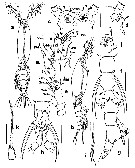
Issued from : E. Suarez-Morales, A. Goruppi, A. de Olazabal & V. Tirelli
in J. Nat. Hist., 2017, 51 (31-32) [p.1812, Fig.6].
Female (from Trieste): a-b, habitus (dorsal and lateral, respectively); c, cephalic region showing frontal ornamentation (dorsal); d, cephalic region, lateral view, anteriormost ventral protuberance arrowed; e, right A1 with armature (dorsal); f, urosome, dorsal view, showing posterolateral rounded processes on genital double-somite; g, urosome and P5 (setae and ovigerous spines cut short) (lateral); h, urosome and P5 (ventral); i, terminal part of the ovigerous spines (ventral); j, oral papilla and adjacent cuticular ornamentation (lateral); k, 3rd exopodal segment of P3.
Scale bars: 200 µm (a-b); 50 µm (c, d, j, k); 100 µm (e-h).
Nota : - Cephalothorax representing 64 % of total body length (caudal rami excluded)
- Midventral oral papilla located at 25 % of cephalothorax length.
- Pair of relatively small ocelli present, pigment cups moderately developed, medially separated by one eye diameter, weakly pigmented; ventral cup larger than lateral cups. Wide, dorsal symmetrical rounded protuberances surrounding ocelli (arrowed in Fig.6c) and adjacent lateral expansions in cephalic section
- Cephalic area with weakly produced forehead, ornamented.
- A pair of sensilla.
- Urosome of 3 pedigerous somites, together representing 10 % of total body length . Relative lengths of urosomites 36.1 : 41.3 : 22.6 = 100.
- Genital double-somite with smooth dorsal and ventral surfaces, with rounded posterior process on lateral margin, visible in dorsal view (arrows in Fig. 6f, g).
- Ovigerous spines paired, relatively short, representing 21 % of total body length; spine basally separated, slender, straight at their base and along shaft, without distal expansions and tapering distally, spines subequally long. Insertion of ovigerous spines with adjacent curved row of slender, short spinules.
- Caudal ramus subquadrate, armed with 3 subequally long, sparsely setulated caudal setae.
- A1 relatively long, remarkably divergent, representing about 25.6 % of thotal length and 41 % of cephalothorax length. A1 4 segmented, segments 3-4 completely fused; intersegmental division between these segments markede by elongated, relatively narrow section. Distal segment longest, representing 49 % of A1 length.
- Incorporated 1st pedigerous somite and succeding 3 pedigerous somites each bearing a pair of biramous legs. Pedigerous somites 2-4, together accounting for 17 % of total body length in dorsal view.
- P5medially conjointed, bilobate, inner (endopodal) lobe elongate, thumb-like, unarmed, rounded distally, reaching about 3/4 the length of outer lobe. Outer (exopodal) lobe elongated, slender, armed with 2 long setae on distal position plus short, slender innermost seta.




